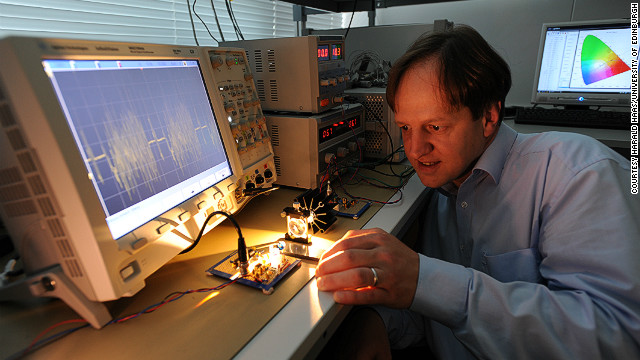Li-Fi get WiFi From Light

Nan told Xinhua News that a microchipped bulb has the ability to produce data speeds of up to 150 megabits per second (Mbps). Researchers claim that a one-watt LED light bulb would provide net connectivity to four computers.
However there has been no supporting video or photos to back these claims up, sparking questions as to the validity of the findings.

A spokesperson from PureVLC said of the latest findings: “We’re just as surprised as everyone else by this announcement, but how valid this is we don’t know without seeing more evidence. We remain sceptical.”
A microchipped bulb can produce data speeds of up to 150 megabits per second (Mbps), Chi Nan, IT professor at Shanghai's Fudan University told Xinhua News.
A one-watt LED light bulb would be enough to provide net connectivity to four computers, researchers say.
But experts told the BBC more evidence was needed to back up the claims.
There are no supporting video or photos showing the technology in action.
Li-fi, also known as visible light communications (VLC), at these speeds would be faster - and cheaper - than the average Chinese broadband connection.
In 2011, Prof Harald Haas, an expert in optical wireless communications at the University of Edinburgh, demonstrated how an LED bulb equipped with signal processing technology could stream a high-definition video to a computer.
He coined the term "light fidelity" or li-fi and set up a private company, PureVLC, to exploit the technology.
Edinburgh University's Prof Harald Haas coined the term "li-fi"
"We're just as surprised as everyone else by this announcement," PureVLC spokesman Nikola Serafimovski told the BBC."But how valid this is we don't know without seeing more evidence. We remain sceptical."
This year, the Fraunhofer Heinrich Hertz Institute claimed that data rates of up to 1Gbit/s per LED light frequency were possible in laboratory conditions, making one bulb with three colours potentially capable of transmitting data at up to 3Gbit/s.
Unlimited capacity

Visible light is part of the electromagnetic spectrum and 10,000 times bigger than the radio spectrum, affording potentially unlimited capacity.
But there are drawbacks: block the light and you block the signal.
However, this is also a potential advantage from a security point of view. Light cannot penetrate walls as radio signals can, so drive-by hacking of wireless internet signals would be far more difficult, if not impossible.
Prof Chi's research team includes scientists from the Shanghai Institute of Technical Physics at the Chinese Academy of Sciences, the report says.
She admitted that the technology was still in its infancy and needed further developments in microchip design and optical communication controls before it could go mass market.
Her team is hoping to show off sample li-fi kits at the China International Industry Fair in Shanghai on 5 November, the report said.
More Efficient
Despite the sceptism, li-fi still promises to be cheaper and more efficient due to the fact that LED bulbs are universal and the lighting infrastructure is already in place.Compared to the radio spectrum, visible light which is part of the electromagnetic spectrum is 10,000 times bigger and therefore has potential unlimited capacity.
By blocking the light, the signal is blocked. Although this is a possible drawback, it also has its advantages. Because light cannot penetrate walls, it would make it near enough impossible for drive-by hackers to use others people’s internet.
Professor Chi has admitted that the technology still needs further developments in microchip design and communication controls but the team is hoping to show off sample li-fi kits at the China International Industry Fair in Shanghai on 5 November.